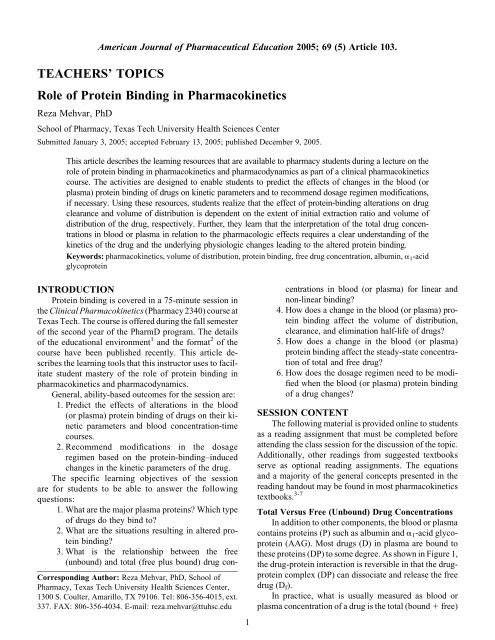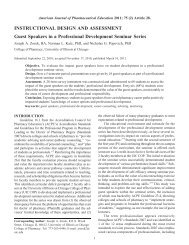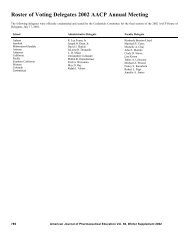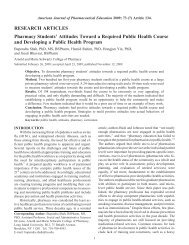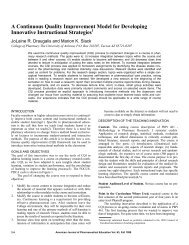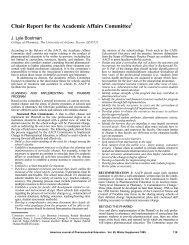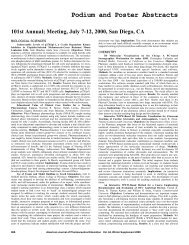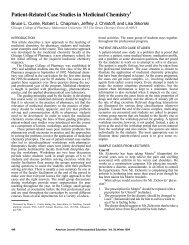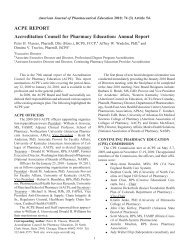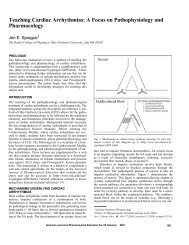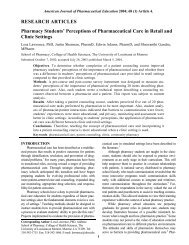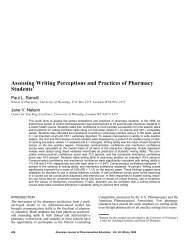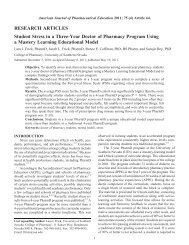TOPICS Role of Protein Binding in Pharmacokinetics - AJPE
TOPICS Role of Protein Binding in Pharmacokinetics - AJPE
TOPICS Role of Protein Binding in Pharmacokinetics - AJPE
Create successful ePaper yourself
Turn your PDF publications into a flip-book with our unique Google optimized e-Paper software.
American Journal <strong>of</strong> Pharmaceutical Education 2005; 69 (5) Article 103.<br />
TEACHERS’ <strong>TOPICS</strong><br />
<strong>Role</strong> <strong>of</strong> <strong>Prote<strong>in</strong></strong> <strong>B<strong>in</strong>d<strong>in</strong>g</strong> <strong>in</strong> Pharmacok<strong>in</strong>etics<br />
Reza Mehvar, PhD<br />
School <strong>of</strong> Pharmacy, Texas Tech University Health Sciences Center<br />
Submitted January 3, 2005; accepted February 13, 2005; published December 9, 2005.<br />
This article describes the learn<strong>in</strong>g resources that are available to pharmacy students dur<strong>in</strong>g a lecture on the<br />
role <strong>of</strong> prote<strong>in</strong> b<strong>in</strong>d<strong>in</strong>g <strong>in</strong> pharmacok<strong>in</strong>etics and pharmacodynamics as part <strong>of</strong> a cl<strong>in</strong>ical pharmacok<strong>in</strong>etics<br />
course. The activities are designed to enable students to predict the effects <strong>of</strong> changes <strong>in</strong> the blood (or<br />
plasma) prote<strong>in</strong> b<strong>in</strong>d<strong>in</strong>g <strong>of</strong> drugs on k<strong>in</strong>etic parameters and to recommend dosage regimen modifications,<br />
if necessary. Us<strong>in</strong>g these resources, students realize that the effect <strong>of</strong> prote<strong>in</strong>-b<strong>in</strong>d<strong>in</strong>g alterations on drug<br />
clearance and volume <strong>of</strong> distribution is dependent on the extent <strong>of</strong> <strong>in</strong>itial extraction ratio and volume <strong>of</strong><br />
distribution <strong>of</strong> the drug, respectively. Further, they learn that the <strong>in</strong>terpretation <strong>of</strong> the total drug concentrations<br />
<strong>in</strong> blood or plasma <strong>in</strong> relation to the pharmacologic effects requires a clear understand<strong>in</strong>g <strong>of</strong> the<br />
k<strong>in</strong>etics <strong>of</strong> the drug and the underly<strong>in</strong>g physiologic changes lead<strong>in</strong>g to the altered prote<strong>in</strong> b<strong>in</strong>d<strong>in</strong>g.<br />
Keywords: pharmacok<strong>in</strong>etics, volume <strong>of</strong> distribution, prote<strong>in</strong> b<strong>in</strong>d<strong>in</strong>g, free drug concentration, album<strong>in</strong>, a 1 -acid<br />
glycoprote<strong>in</strong><br />
Correspond<strong>in</strong>g Author: Reza Mehvar, PhD, School <strong>of</strong><br />
Pharmacy, Texas Tech University Health Sciences Center,<br />
1300 S. Coulter, Amarillo, TX 79106. Tel: 806-356-4015, ext.<br />
337. FAX: 806-356-4034. E-mail: reza.mehvar@ttuhsc.edu<br />
1<br />
INTRODUCTION<br />
<strong>Prote<strong>in</strong></strong> b<strong>in</strong>d<strong>in</strong>g is covered <strong>in</strong> a 75-m<strong>in</strong>ute session <strong>in</strong><br />
the Cl<strong>in</strong>ical Pharmacok<strong>in</strong>etics (Pharmacy 2340) course at<br />
Texas Tech. The course is <strong>of</strong>fered dur<strong>in</strong>g the fall semester<br />
<strong>of</strong> the second year <strong>of</strong> the PharmD program. The details<br />
<strong>of</strong> the educational environment 1 and the format 2 <strong>of</strong> the<br />
course have been published recently. This article describes<br />
the learn<strong>in</strong>g tools that this <strong>in</strong>structor uses to facilitate<br />
student mastery <strong>of</strong> the role <strong>of</strong> prote<strong>in</strong> b<strong>in</strong>d<strong>in</strong>g <strong>in</strong><br />
pharmacok<strong>in</strong>etics and pharmacodynamics.<br />
General, ability-based outcomes for the session are:<br />
1. Predict the effects <strong>of</strong> alterations <strong>in</strong> the blood<br />
(or plasma) prote<strong>in</strong> b<strong>in</strong>d<strong>in</strong>g <strong>of</strong> drugs on their k<strong>in</strong>etic<br />
parameters and blood concentration-time<br />
courses.<br />
2. Recommend modifications <strong>in</strong> the dosage<br />
regimen based on the prote<strong>in</strong>-b<strong>in</strong>d<strong>in</strong>g–<strong>in</strong>duced<br />
changes <strong>in</strong> the k<strong>in</strong>etic parameters <strong>of</strong> the drug.<br />
The specific learn<strong>in</strong>g objectives <strong>of</strong> the session<br />
are for students to be able to answer the follow<strong>in</strong>g<br />
questions:<br />
1. What are the major plasma prote<strong>in</strong>s? Which type<br />
<strong>of</strong> drugs do they b<strong>in</strong>d to?<br />
2. What are the situations result<strong>in</strong>g <strong>in</strong> altered prote<strong>in</strong><br />
b<strong>in</strong>d<strong>in</strong>g?<br />
3. What is the relationship between the free<br />
(unbound) and total (free plus bound) drug concentrations<br />
<strong>in</strong> blood (or plasma) for l<strong>in</strong>ear and<br />
non-l<strong>in</strong>ear b<strong>in</strong>d<strong>in</strong>g?<br />
4. How does a change <strong>in</strong> the blood (or plasma) prote<strong>in</strong><br />
b<strong>in</strong>d<strong>in</strong>g affect the volume <strong>of</strong> distribution,<br />
clearance, and elim<strong>in</strong>ation half-life <strong>of</strong> drugs?<br />
5. How does a change <strong>in</strong> the blood (or plasma)<br />
prote<strong>in</strong> b<strong>in</strong>d<strong>in</strong>g affect the steady-state concentration<br />
<strong>of</strong> total and free drug?<br />
6. How does the dosage regimen need to be modified<br />
when the blood (or plasma) prote<strong>in</strong> b<strong>in</strong>d<strong>in</strong>g<br />
<strong>of</strong> a drug changes?<br />
SESSION CONTENT<br />
The follow<strong>in</strong>g material is provided onl<strong>in</strong>e to students<br />
as a read<strong>in</strong>g assignment that must be completed before<br />
attend<strong>in</strong>g the class session for the discussion <strong>of</strong> the topic.<br />
Additionally, other read<strong>in</strong>gs from suggested textbooks<br />
serve as optional read<strong>in</strong>g assignments. The equations<br />
and a majority <strong>of</strong> the general concepts presented <strong>in</strong> the<br />
read<strong>in</strong>g handout may be found <strong>in</strong> most pharmacok<strong>in</strong>etics<br />
textbooks. 3-7<br />
Total Versus Free (Unbound) Drug Concentrations<br />
In addition to other components, the blood or plasma<br />
conta<strong>in</strong>s prote<strong>in</strong>s (P) such as album<strong>in</strong> and a 1 -acid glycoprote<strong>in</strong><br />
(AAG). Most drugs (D) <strong>in</strong> plasma are bound to<br />
these prote<strong>in</strong>s (DP) to some degree. As shown <strong>in</strong> Figure 1,<br />
the drug-prote<strong>in</strong> <strong>in</strong>teraction is reversible <strong>in</strong> that the drugprote<strong>in</strong><br />
complex (DP) can dissociate and release the free<br />
drug (D f ).<br />
In practice, what is usually measured as blood or<br />
plasma concentration <strong>of</strong> a drug is the total (bound 1 free)
American Journal <strong>of</strong> Pharmaceutical Education 2005; 69 (5) Article 103.<br />
Figure 1. The pharmacok<strong>in</strong>etic model depict<strong>in</strong>g the<br />
equilibrium between the free (D f ) and prote<strong>in</strong>-bound (DP)<br />
drug <strong>in</strong> blood and tissue. The model assumes that only the free<br />
drug is subject to elim<strong>in</strong>ation and distribution <strong>in</strong>to the tissues<br />
(<strong>in</strong>clud<strong>in</strong>g the site <strong>of</strong> action).<br />
drug concentration <strong>in</strong> the sample. However, it is the free<br />
drug (D f ) that can pass the cell membranes and reach its<br />
site <strong>of</strong> action; the drug-prote<strong>in</strong> complex (DP) is too large<br />
to pass through the membranes (Figure 1). Therefore, the<br />
free drug is the moiety responsible for produc<strong>in</strong>g the pharmacologic<br />
effect. At equilibrium, the percent or fraction<br />
<strong>of</strong> the total drug bound to plasma prote<strong>in</strong>s and red blood<br />
cells rema<strong>in</strong>s constant for drugs with l<strong>in</strong>ear b<strong>in</strong>d<strong>in</strong>g. For<br />
example, the degree <strong>of</strong> plasma prote<strong>in</strong> b<strong>in</strong>d<strong>in</strong>g <strong>of</strong> phenyto<strong>in</strong><br />
<strong>in</strong> adults is 90% or 0.90 (the percent or fraction<br />
unbound is 10% or 0.10). So, if the total plasma concentration<br />
<strong>of</strong> phenyto<strong>in</strong> is 20 mg/L, the free concentration is<br />
2 mg/L, and the bound concentration is 18 mg/L. This<br />
ratio rema<strong>in</strong>s constant when the concentration is reduced<br />
to 15 mg/L: the free concentration is 1.5 mg/L and the<br />
bound concentration is 13.5 mg/L. Therefore, because<br />
the change <strong>in</strong> the free drug concentration (responsible<br />
for the pharmacologic effect) is proportional to that for<br />
the total drug concentration, a measurement <strong>of</strong> the total<br />
drug concentration <strong>in</strong> practice can result <strong>in</strong> a prediction<br />
<strong>of</strong> the desired effects <strong>in</strong> most cases.<br />
The problem arises, however, when a disease or coadm<strong>in</strong>istration<br />
<strong>of</strong> another drug would change the b<strong>in</strong>d<strong>in</strong>g<br />
equilibrium ratios. For <strong>in</strong>stance, <strong>in</strong> patients with hypoalbum<strong>in</strong>emia,<br />
the degree <strong>of</strong> b<strong>in</strong>d<strong>in</strong>g <strong>of</strong> phenyto<strong>in</strong> to album<strong>in</strong><br />
is reduced. Therefore, the free fraction <strong>in</strong> this case<br />
will be higher than normal. Consequently, a total plasma<br />
concentration <strong>of</strong> 20 mg/L, which under normal conditions<br />
resulted <strong>in</strong> a free concentration <strong>of</strong> 2 mg/L, would now<br />
result <strong>in</strong> a free concentration higher than 2 mg/L for these<br />
patients. This, however, will not be apparent by just measur<strong>in</strong>g<br />
the total drug. Therefore, it is necessary to understand<br />
the effects <strong>of</strong> changes <strong>in</strong> the prote<strong>in</strong> b<strong>in</strong>d<strong>in</strong>g on<br />
various k<strong>in</strong>etic parameters and the total and free drug<br />
concentrations <strong>in</strong> order to <strong>in</strong>terpret the total plasma or<br />
blood concentrations and appropriately adjust the dosage<br />
regimen, if necessary.<br />
Additionally, prote<strong>in</strong> b<strong>in</strong>d<strong>in</strong>g <strong>of</strong> some drugs <strong>in</strong> the blood<br />
or plasma may be nonl<strong>in</strong>ear. This means that as the total<br />
blood concentrations <strong>of</strong> the drug <strong>in</strong>crease, the free fraction<br />
2<br />
also <strong>in</strong>creases, result<strong>in</strong>g <strong>in</strong> a more than proportional <strong>in</strong>crease<br />
<strong>in</strong> the free drug concentration at higher total drug concentrations.<br />
In other words, at higher concentrations, the sites<br />
responsible for b<strong>in</strong>d<strong>in</strong>g the drug are saturated, therefore,<br />
a greater proportion <strong>of</strong> the drug is <strong>in</strong> free form. One <strong>of</strong> the<br />
examples <strong>of</strong> such drugs is disopyramide, which shows<br />
higher plasma free fractions at higher therapeutic concentrations.<br />
For these drugs, <strong>in</strong>terpretation <strong>of</strong> the total plasma<br />
concentration is extremely difficult. Therefore, experimental<br />
measurement <strong>of</strong> free drug, as opposed to normally measured<br />
total drug, may be necessary <strong>in</strong> these cases.<br />
Major Plasma <strong>Prote<strong>in</strong></strong>s<br />
Album<strong>in</strong> is the most important plasma prote<strong>in</strong> with<br />
a concentration <strong>of</strong> 3.5 to 5 g/dL (Table 1). Most acidic<br />
(anionic) drugs b<strong>in</strong>d to plasma album<strong>in</strong>. Some examples<br />
<strong>in</strong>clude tolbutamide, phenyto<strong>in</strong>, ibupr<strong>of</strong>en, naproxen, and<br />
warfar<strong>in</strong>. Album<strong>in</strong> is synthesized <strong>in</strong> the liver. Therefore,<br />
the concentrations <strong>of</strong> album<strong>in</strong> may be reduced <strong>in</strong> liver<br />
diseases such as cirrhosis, result<strong>in</strong>g <strong>in</strong> changes <strong>in</strong> the prote<strong>in</strong><br />
b<strong>in</strong>d<strong>in</strong>g <strong>of</strong> the above drugs. Other diseases caus<strong>in</strong>g a<br />
reduction <strong>in</strong> the plasma concentrations <strong>of</strong> album<strong>in</strong> <strong>in</strong>clude<br />
burns, surgery, acute viral hepatitis, renal failure, and<br />
malnutrition. On the other hand, an <strong>in</strong>crease <strong>in</strong> the plasma<br />
concentrations <strong>of</strong> album<strong>in</strong> is observed <strong>in</strong> situations like<br />
dehydration and some neurological disorders. However,<br />
cl<strong>in</strong>ically, occurrence <strong>of</strong> hypoalbum<strong>in</strong>emia is much more<br />
frequent than hyperalbum<strong>in</strong>emia.<br />
In addition to the concentration, the aff<strong>in</strong>ity <strong>of</strong> album<strong>in</strong>tob<strong>in</strong>ddrugscanaffectthedegree<strong>of</strong>prote<strong>in</strong>b<strong>in</strong>d<strong>in</strong>g<br />
<strong>of</strong> drugs. The aff<strong>in</strong>ity <strong>of</strong> album<strong>in</strong> for b<strong>in</strong>d<strong>in</strong>g drugs may<br />
be decreased by some other drugs or <strong>in</strong> diseases, result<strong>in</strong>g<br />
<strong>in</strong> higher free fractions <strong>in</strong> plasma. 8 Additionally,<br />
drugs with higher aff<strong>in</strong>ity to album<strong>in</strong> may displace drugs<br />
with lower aff<strong>in</strong>ity from their b<strong>in</strong>d<strong>in</strong>g sites. For <strong>in</strong>stance,<br />
salicylates are capable <strong>of</strong> displac<strong>in</strong>g warfar<strong>in</strong> from<br />
the plasma album<strong>in</strong> and <strong>in</strong>creas<strong>in</strong>g the free fraction <strong>of</strong><br />
warfar<strong>in</strong>.<br />
AAG has a much lower concentration (0.04-0.1 g/dL)<br />
than album<strong>in</strong> and b<strong>in</strong>ds mostly to basic (cationic) and<br />
neutral drugs (Table 1). Similar to album<strong>in</strong>, AAG is synthesized<br />
<strong>in</strong> the liver. Most drugs that b<strong>in</strong>d to AAG also<br />
b<strong>in</strong>d to album<strong>in</strong>. Examples <strong>of</strong> such drugs are propranolol,<br />
lidoca<strong>in</strong>e, verapamil, disopyramide, and imipram<strong>in</strong>e. In<br />
contrast to album<strong>in</strong>, cl<strong>in</strong>ical situations result<strong>in</strong>g <strong>in</strong> higher<br />
concentrations <strong>of</strong> AAG are more frequent than those<br />
result<strong>in</strong>g <strong>in</strong> lower concentrations <strong>of</strong> this b<strong>in</strong>d<strong>in</strong>g prote<strong>in</strong>.<br />
The plasma concentrations <strong>of</strong> AAG are <strong>in</strong>creased <strong>in</strong><br />
trauma <strong>in</strong>juries, <strong>in</strong>flammatory diseases, surgery, burns,<br />
and acute myocardial <strong>in</strong>farction. Liver diseases such as<br />
cirrhosis would cause a reduction <strong>in</strong> the plasma concentrations<br />
<strong>of</strong> AAG. Similar to album<strong>in</strong>, an apparent decrease
American Journal <strong>of</strong> Pharmaceutical Education 2005; 69 (5) Article 103.<br />
Table 1. Major Drug <strong>B<strong>in</strong>d<strong>in</strong>g</strong> <strong>Prote<strong>in</strong></strong>s <strong>in</strong> Plasma 4,7 Normal Concentration<br />
<strong>Prote<strong>in</strong></strong> MW, g/mole g/dL mM Type <strong>of</strong> Drugs Bound Example<br />
Album<strong>in</strong> 67,000 3.5-5 500-700 acidic, basic Warfar<strong>in</strong><br />
a 1 -Acid glycoprote<strong>in</strong> 42,000 0.04-0.1 9-23 basic, neutral Propranolol<br />
Lipoprote<strong>in</strong>s 200,000-2,400,000 Varies Varies lipophilic basic and neutral Cyclospor<strong>in</strong>e<br />
<strong>in</strong> the aff<strong>in</strong>ity for b<strong>in</strong>d<strong>in</strong>g to AAG can occur when one<br />
drug displaces the other from its b<strong>in</strong>d<strong>in</strong>g sites.<br />
Lipoprote<strong>in</strong>s, which consist <strong>of</strong> very low-density lipoprote<strong>in</strong>s,<br />
low-density lipoprote<strong>in</strong>s, and high-density<br />
lipoprote<strong>in</strong>s, are synthesized <strong>in</strong> the liver and <strong>in</strong>test<strong>in</strong>al<br />
mucosa, and their normal plasma concentrations are<br />
variable (,0.5 g/dL; Table 1). Usually, basic and neutral<br />
drugs with a high degree <strong>of</strong> lipophilicity are substantially<br />
bound to lipoprote<strong>in</strong>s. The concentrations <strong>of</strong><br />
lipoprote<strong>in</strong>s change <strong>in</strong> a variety <strong>of</strong> diseases such as renal<br />
failure, diabetes mellitus, hyperlipoprote<strong>in</strong>emia, and<br />
alcoholism. Examples <strong>of</strong> drugs significantly b<strong>in</strong>d<strong>in</strong>g to lipoprote<strong>in</strong>s<br />
are cyclospor<strong>in</strong>e, 9 tacrolimus, 10 and prop<strong>of</strong>ol. 11<br />
Blood Versus Plasma<br />
The pharmacok<strong>in</strong>etic parameters <strong>of</strong> drugs are usually<br />
estimated after measurement <strong>of</strong> drugs <strong>in</strong> plasma rather<br />
than whole blood. However, the relationships between<br />
major pharmacok<strong>in</strong>etic parameters (such as volume <strong>of</strong><br />
distribution or clearance) and their physiological determ<strong>in</strong>ants<br />
(such as perfusion or prote<strong>in</strong> b<strong>in</strong>d<strong>in</strong>g) are based<br />
on the value <strong>of</strong> these parameters <strong>in</strong> blood. If the blood:<br />
plasma concentration ratio <strong>of</strong> a drug is equal to 1, the<br />
k<strong>in</strong>etic parameters obta<strong>in</strong>ed us<strong>in</strong>g the plasma and blood<br />
will be identical. Additionally, for drugs with a blood to<br />
plasma ratio different than 1, the plasma concentrations<br />
may be easily converted to the respective blood values if<br />
the blood to plasma ratio is known. Unfortunately, most<br />
reports <strong>in</strong> the literature use blood and plasma k<strong>in</strong>etic<br />
values <strong>in</strong>terchangeably, even if it is not shown that the<br />
blood to plasma ratio is equal to 1. In the follow<strong>in</strong>g<br />
section, we will base our discussion on blood data and<br />
provide alternative relationships, if they exist, for the<br />
plasma data. For simplicity, when literature examples<br />
are used to demonstrate concepts, we assume a blood<br />
to plasma ratio <strong>of</strong> 1.<br />
How Does <strong>Prote<strong>in</strong></strong> <strong>B<strong>in</strong>d<strong>in</strong>g</strong> Affect Major<br />
Pharmacok<strong>in</strong>etic Parameters?<br />
Volume <strong>of</strong> distribution. The volume <strong>of</strong> distribution<br />
at steady state (V SS ) may be def<strong>in</strong>ed by the follow<strong>in</strong>g<br />
equation 3 :<br />
<br />
V SS 5 V B 1<br />
f <br />
ub<br />
V T<br />
ð1Þ<br />
f ut<br />
3<br />
where V B and V T are the volume <strong>of</strong> blood and tissue<br />
(extravascular space), and f ub and f ut are the unbound<br />
fractions <strong>in</strong> the blood and tissue, respectively. V B is<br />
~0.07 L/kg or 5 L/70 kg. V T is the real extravascular<br />
volume <strong>in</strong> which the drug is distributed. For lipophilic<br />
(non-polar) drugs, V T (~0.6 L/kg) is the total body water<br />
m<strong>in</strong>us the blood water volume, because these drugs distribute<br />
to both the extracellular and <strong>in</strong>tracellular spaces.<br />
The value <strong>of</strong> V T for hydrophilic (polar) drugs that do not<br />
penetrate <strong>in</strong>tracellular space is the volume <strong>of</strong> extracellular<br />
water m<strong>in</strong>us the plasma water volume (~0.13 L/kg). 5<br />
As mentioned above, the concentrations <strong>of</strong> drugs are<br />
mostly measured <strong>in</strong> plasma (<strong>in</strong>stead <strong>of</strong> whole blood), and<br />
free fractions are also estimated <strong>in</strong> plasma (f up ). However,<br />
if the blood:plasma concentration ratio <strong>of</strong> the drug is<br />
known, f ub may be easily estimated from f up and blood<br />
to plasma ratio as demonstrated below:<br />
f ub 5 f up<br />
ð2Þ<br />
B:P<br />
In the absence <strong>of</strong> blood to plasma ratio, another parameter,<br />
V SS based on the plasma data (V9 SS ), may be<br />
estimated us<strong>in</strong>g the follow<strong>in</strong>g equation:<br />
<br />
VSS 0 5 V P 1<br />
f up<br />
f ut<br />
<br />
V 0 T<br />
ð3Þ<br />
where V9 SS is a proportionality constant relat<strong>in</strong>g the<br />
amount <strong>of</strong> drug <strong>in</strong> the body to the plasma concentrations<br />
(as opposed to blood concentration for V SS ). V9 T is different<br />
from V T <strong>in</strong> that it also conta<strong>in</strong>s the volume <strong>of</strong> red blood<br />
cells <strong>in</strong> addition to the extravascular space. 3 For drugs that<br />
are restricted to plasma (such as macromolecules), V P is<br />
equal to the volume <strong>of</strong> plasma (~3 L/70 kg). However,<br />
because plasma prote<strong>in</strong>s such as album<strong>in</strong> enter slowly <strong>in</strong>to<br />
the <strong>in</strong>terstitial fluid, at equilibrium V P may be larger than<br />
the volume <strong>of</strong> plasma (~7 L/70 kg or 0.10 L/kg) for small<br />
molecule drugs. 4<br />
As one may recognize from the above equations, V SS<br />
may differ significantly from V9 SS . However, most <strong>in</strong>vestigators<br />
use these 2 terms <strong>in</strong>terchangeably, which is correct<br />
only if the blood to plasma ratio is equal to unity.<br />
Conceptually, these equations predict a larger V SS (or<br />
V9 SS )iff ub (or f up ) is <strong>in</strong>creased and a lower V SS (or V9 SS )if<br />
f ut is <strong>in</strong>creased. This is understandable because a higher<br />
free fraction <strong>in</strong> blood/plasma results <strong>in</strong> a movement <strong>of</strong> the
American Journal <strong>of</strong> Pharmaceutical Education 2005; 69 (5) Article 103.<br />
free drug from blood/plasma to the tissues and an <strong>in</strong>crease<br />
<strong>in</strong> the distribution <strong>of</strong> the drug. On the other hand, a higher<br />
free fraction <strong>in</strong> the tissue would result <strong>in</strong> a movement <strong>of</strong><br />
the drug from the tissue to blood/plasma and a reduction<br />
<strong>in</strong> the volume <strong>of</strong> distribution. The magnitude <strong>of</strong> the<br />
<strong>in</strong>creases or decreases <strong>in</strong> V SS (or V9 SS ), however, depends<br />
on the orig<strong>in</strong>al V SS (or V9 SS ).<br />
At one extreme, a drug with a very low V SS (or V9 SS )<br />
will have a V SS (or V9 SS ) almost equal to V B (or V P ),<br />
mean<strong>in</strong>g that the drug does not distribute much <strong>in</strong>to the<br />
tissues. For these drugs, the above equations may be simplified<br />
as:<br />
V SS V B<br />
ð4Þ<br />
V 0 SS V P<br />
ð5Þ<br />
Therefore, changes <strong>in</strong> the blood/plasma or tissue<br />
b<strong>in</strong>d<strong>in</strong>g (f ub /f up or f ut ) would not significantly affect<br />
the V SS (or V9 SS ) <strong>of</strong> these drugs. Examples <strong>of</strong> such<br />
drugs are chlorpropamide (V9 SS <strong>of</strong> 0.097 L/kg), tolbutamide<br />
(V9 SS <strong>of</strong> ~0.1 L/kg), and dicloxacill<strong>in</strong> (V9 SS <strong>of</strong><br />
0.086 L/kg). 12<br />
At the other extreme, for drugs with very large V SS<br />
(or V9 SS ), the value <strong>of</strong> V B (or V P ) is relatively <strong>in</strong>significant,<br />
and the above equation may be rewritten as:<br />
<br />
V SS <br />
f <br />
ub<br />
V T<br />
ð6Þ<br />
f ut<br />
V 0 SS <br />
<br />
f <br />
up<br />
VT<br />
0 f ut<br />
ð7Þ<br />
Therefore, changes <strong>in</strong> the values <strong>of</strong> f ub /f up or f ut would<br />
affect the value <strong>of</strong> V SS (or V9 SS ) almost proportionally.<br />
Examples <strong>of</strong> such drugs are propranolol (V SS <strong>of</strong> 4.3 L/kg)<br />
and amitriptyl<strong>in</strong>e (V SS <strong>of</strong> 15 L/kg). 12 Most drugs, however,<br />
fall <strong>in</strong> between these 2 categories; thus, their V SS<br />
is affected to some degree (less than proportional) by<br />
changes <strong>in</strong> f ub and/or f ut . In conclusion, the effect <strong>of</strong><br />
changes <strong>in</strong> f ub or f ut on V SS depends on the <strong>in</strong>itial extent<br />
<strong>of</strong> the distribution <strong>of</strong> the drug.<br />
Clearance. Based on the well-stirred model <strong>of</strong> hepatic<br />
metabolism, the hepatic clearance (Cl h ) is related to hepatic<br />
extraction ratio (E) and its components f ub , <strong>in</strong>tr<strong>in</strong>sic<br />
clearance <strong>of</strong> the free drug (Cl9 <strong>in</strong>t ), and liver blood flow (Q)<br />
accord<strong>in</strong>g to the follow<strong>in</strong>g equation: 4<br />
Cl h 5 Q E 5 Q<br />
f ub Cl<strong>in</strong>t<br />
0<br />
Q 1 f ub Cl<strong>in</strong>t<br />
0 ð8Þ<br />
Accord<strong>in</strong>g to the above equation, drugs with a high E<br />
(close to 1) have a high clearance close to the hepatic<br />
blood flow, whereas drugs with a low E (E close to zero)<br />
4<br />
have a low Cl significantly less than the hepatic blood<br />
flow. For these 2 extreme cases <strong>of</strong> very low and very high<br />
E (or Cl) drugs, the above equation may be simplified:<br />
Cl f ub Cl<strong>in</strong>t 0 ; for low E or low Cl ð9Þ<br />
Cl Q; for high E or high Cl<br />
ð10Þ<br />
Therefore, a change <strong>in</strong> f ub for the low E (or low Cl)<br />
drugs would directly affect their Cl h . Examples <strong>of</strong> drugs<br />
with low E (or low Cl) are phenyto<strong>in</strong>, diazepam, warfar<strong>in</strong>,<br />
and valproic acid. On the other hand, a change <strong>in</strong> the f ub <strong>of</strong><br />
high E (high Cl) drugs would not have any effect on their<br />
Cl. Examples <strong>of</strong> high E (high Cl) drugs are tricyclic antidepressants,<br />
verapamil, and propranolol.<br />
In contrast to all or none effects for high and low Cl<br />
drugs, a change <strong>in</strong> the f ub <strong>of</strong> a drug with an <strong>in</strong>termediate Cl<br />
or E would have some effect on its clearance. However,<br />
the change <strong>in</strong> clearance will not be proportional to the<br />
change <strong>in</strong> f ub .<br />
The effect <strong>of</strong> f ub on the renal clearance <strong>of</strong> drugs is also<br />
similar to those expla<strong>in</strong>ed for hepatic clearance <strong>in</strong> that the<br />
drugs with low renal E are affected most and those with<br />
high renal E are affected least by changes <strong>in</strong> f ub . Examples<br />
<strong>of</strong> high and low renal E drugs are penicill<strong>in</strong>s and gentamic<strong>in</strong>,<br />
respectively.<br />
In conclusion, the effect <strong>of</strong> changes <strong>in</strong> f ub <strong>of</strong> drugs on<br />
their clearance is dependent on the <strong>in</strong>itial clearance or E<br />
<strong>of</strong> the drug.<br />
Half-life. The elim<strong>in</strong>ation half-life is not an <strong>in</strong>dependent<br />
parameter and only reflects the magnitude <strong>of</strong><br />
distribution and elim<strong>in</strong>ation. 1 The half-life is dependent<br />
on both V and Cl as def<strong>in</strong>ed below:<br />
t 1=2 5 0:693V<br />
ð11Þ<br />
Cl<br />
Therefore, the effect <strong>of</strong> changes <strong>in</strong> f ub <strong>of</strong> drugs on<br />
their half-life is dependent on the changes <strong>in</strong> V and/or<br />
Cl <strong>in</strong>duced by the alterations <strong>in</strong> prote<strong>in</strong> b<strong>in</strong>d<strong>in</strong>g.<br />
The Case for Four Extreme Scenarios<br />
As examples <strong>of</strong> the effects <strong>of</strong> prote<strong>in</strong> b<strong>in</strong>d<strong>in</strong>g on the<br />
k<strong>in</strong>etics and dosage requirement <strong>of</strong> drugs, let us consider<br />
the follow<strong>in</strong>g four scenarios.<br />
Drugs with high clearance and large volume <strong>of</strong><br />
distribution. Because the clearance <strong>of</strong> these drugs is<br />
mostly controlled by the blood flow (Cl 5 Q), a change<br />
<strong>in</strong> f ub is not expected to affect the clearance <strong>of</strong> these drugs.<br />
On the other hand, the V SS <strong>of</strong> large volume drugs are<br />
almost proportional to the free fraction <strong>of</strong> the drug <strong>in</strong><br />
blood (V SS [(f ub /f ut ) 3 V T ]). Therefore, an <strong>in</strong>crease <strong>in</strong><br />
the blood free fraction, for example, would result <strong>in</strong> an<br />
almost proportional <strong>in</strong>crease <strong>in</strong> the V SS <strong>of</strong> these drugs.
American Journal <strong>of</strong> Pharmaceutical Education 2005; 69 (5) Article 103.<br />
Consequently, the half-life will be prolonged proportionally.<br />
Because the clearance does not change<br />
(4), the total average steady state concentration<br />
(C ‘ ave) after <strong>in</strong>travenous adm<strong>in</strong>istration rema<strong>in</strong>s the<br />
same (4):<br />
4C ave ‘ 5 Dose=t<br />
ð12Þ<br />
4Cl<br />
Consequently, based on the total concentrations,<br />
one may assume that no adjustment <strong>in</strong> dos<strong>in</strong>g rate<br />
is necessary. However, because the free fraction <strong>of</strong><br />
the drug <strong>in</strong> blood is <strong>in</strong>creased ([), the average steady<br />
state concentration <strong>of</strong> the free drug (C ‘ ave,free) will<br />
be <strong>in</strong>creased ([), which may result <strong>in</strong> toxicity or<br />
adverse effects despite apparently ‘‘normal’’ total<br />
blood values.<br />
[C ave; ‘ free 5 C‘ ave 43[f ub ð13Þ<br />
For these drugs, therefore, a change <strong>in</strong> the free fraction<br />
<strong>in</strong> blood may require adjustment <strong>of</strong> the dos<strong>in</strong>g rate (<strong>in</strong><br />
this case, a reduction).<br />
An example <strong>of</strong> such drugs is propranolol with V SS <strong>of</strong><br />
4.3 L/kg, Cl <strong>of</strong> 16 mL/m<strong>in</strong>/kg, and f up <strong>of</strong> 0.13, respectively.<br />
12 Patients with acute myocardial <strong>in</strong>farction have<br />
higher AAG concentrations <strong>in</strong> plasma. 13 Therefore, the<br />
free fraction <strong>of</strong> propranolol <strong>in</strong> plasma <strong>of</strong> these patients<br />
decreases. 13 Because <strong>of</strong> its high E, however, the clearance<br />
and consequently the steady state total concentration <strong>of</strong><br />
<strong>in</strong>travenous propranolol are not expected to change <strong>in</strong><br />
these patients. On the other hand, the lower free fraction<br />
is anticipated to cause a reduction <strong>in</strong> the free concentrations<br />
and pharmacologic effects <strong>of</strong> the drug <strong>in</strong> patients<br />
with acute myocardial <strong>in</strong>farction. Indeed, higher than normal<br />
dos<strong>in</strong>g rates <strong>of</strong> propranolol may be required <strong>in</strong><br />
patients with established <strong>in</strong>farction. 5<br />
Drugs with low clearance and small volume <strong>of</strong><br />
distribution. For drugs with low clearance and small<br />
volume <strong>of</strong> distribution, clearance is proportional to the<br />
free blood fraction (Cl f ub 3 Cl9 <strong>in</strong>t ). Therefore, a<br />
change <strong>in</strong> the free fraction is almost proportionally<br />
reflected <strong>in</strong> the clearance <strong>of</strong> the drug. On the other hand,<br />
the V SS <strong>of</strong> these drugs is not sensitive to changes <strong>in</strong> the<br />
free fractions (V SS V B ). Consequently, the half-life<br />
will <strong>in</strong>crease if f ub is decreased (Cl is decreased), and it<br />
will decrease if f ub is <strong>in</strong>creased (Cl is <strong>in</strong>creased). A<br />
change <strong>in</strong> clearance would result <strong>in</strong> an <strong>in</strong>verse change<br />
<strong>in</strong> the total average steady state concentration. However,<br />
this change is not expected to affect the pharmacologic<br />
effects <strong>of</strong> the drug because the free average steady state<br />
concentration is expected to rema<strong>in</strong> the same. Therefore,<br />
the dos<strong>in</strong>g rate generally does not have to be changed for<br />
these drugs.<br />
An example <strong>of</strong> such drugs is warfar<strong>in</strong> with V9 SS <strong>of</strong><br />
0.14 L/kg, clearance <strong>of</strong> 0.045 mL/m<strong>in</strong>/kg, and f up <strong>of</strong><br />
0.01. 12 Trichloroacetic acid, a metabolite <strong>of</strong> chloral<br />
hydrate, is known to displace warfar<strong>in</strong> from its b<strong>in</strong>d<strong>in</strong>g<br />
site <strong>in</strong> plasma, thereby <strong>in</strong>creas<strong>in</strong>g its f up . 14 Consequently,<br />
the clearance <strong>of</strong> warfar<strong>in</strong> <strong>in</strong>creases almost proportionally<br />
to the <strong>in</strong>crease <strong>in</strong> f up , and its half-life decreases. At equilibrium,<br />
the total average steady state concentration <strong>of</strong><br />
warfar<strong>in</strong> <strong>in</strong> this <strong>in</strong>teraction decreases, whereas the free<br />
concentration rema<strong>in</strong>s the same. Therefore, <strong>in</strong> the long<br />
term, the pharmacologic effect rema<strong>in</strong>s the same and no<br />
dosage adjustment is necessary. 14 However, because warfar<strong>in</strong><br />
has a narrow therapeutic range, the <strong>in</strong>itial <strong>in</strong>crease <strong>in</strong><br />
f up before equilibrium (reduction <strong>of</strong> total plasma concentrations)<br />
may result <strong>in</strong> a significant <strong>in</strong>crease <strong>in</strong> the free<br />
drug concentration and pharmacologic effect. Therefore,<br />
a temporary reduction <strong>in</strong> dos<strong>in</strong>g rate may be necessary.<br />
Drugs with low clearance and large volume <strong>of</strong><br />
distribution. Both the clearance and V SS <strong>of</strong> drugs with<br />
low clearance and large volume <strong>of</strong> distribution are very<br />
sensitive to the changes <strong>in</strong> f ub . However, the half-life<br />
rema<strong>in</strong>s almost constant because the effects <strong>of</strong> changes<br />
<strong>in</strong> the clearance and V SS on the half-life are cancelled out.<br />
Similar to the above case, the change <strong>in</strong> the clearance<br />
results <strong>in</strong> a change <strong>in</strong> the total drug concentration. However,<br />
the average free drug concentration rema<strong>in</strong>s the<br />
same. Therefore, there is no need for an adjustment <strong>in</strong><br />
the dos<strong>in</strong>g rate.<br />
Diazepam is an example for this group. Diazepam has<br />
aV9 SS <strong>of</strong> 1.1 L/kg, clearance <strong>of</strong> 0.38 mL/m<strong>in</strong>/kg, and f up<br />
<strong>of</strong> 0.013. 12 Situations result<strong>in</strong>g <strong>in</strong> an <strong>in</strong>crease <strong>in</strong> f up <strong>of</strong> the<br />
drug (eg, hypoalbum<strong>in</strong>emia) are expected to <strong>in</strong>crease both<br />
the V9 SS and clearance <strong>of</strong> the drug (with no significant<br />
change <strong>in</strong> half-life). However, no change <strong>in</strong> the pharmacologic<br />
effect is expected.<br />
Drugs with high clearance and small volume <strong>of</strong><br />
distribution. A change <strong>in</strong> blood prote<strong>in</strong> b<strong>in</strong>d<strong>in</strong>g is not<br />
expected to substantially affect the clearance, V SS ,or<br />
half-life <strong>of</strong> these drugs. Therefore, the total blood concentrations<br />
are expected to rema<strong>in</strong> the same <strong>in</strong> the presence <strong>of</strong><br />
altered prote<strong>in</strong> b<strong>in</strong>d<strong>in</strong>g. However, the free drug concentrations<br />
will change proportional to the changes <strong>in</strong> the free<br />
fraction <strong>in</strong> blood. Therefore, the dos<strong>in</strong>g rate <strong>of</strong> these drugs<br />
needs to be altered despite a ‘‘normal’’ blood concentration<br />
<strong>of</strong> the total drug.<br />
Penicill<strong>in</strong>s belong to this category <strong>of</strong> drugs. Salicylates<br />
<strong>in</strong>crease the free fraction <strong>of</strong> penicill<strong>in</strong>s without caus<strong>in</strong>g<br />
any change <strong>in</strong> their clearance or total concentration. 15<br />
Although the plasma concentration <strong>of</strong> the free drug<br />
<strong>in</strong>creases <strong>in</strong> these situations, <strong>in</strong> practice, no dosage adjustment<br />
is carried out. This is because <strong>of</strong> the high therapeutic<br />
<strong>in</strong>dex and relative safety <strong>of</strong> these drugs.<br />
5
American Journal <strong>of</strong> Pharmaceutical Education 2005; 69 (5) Article 103.<br />
Summary <strong>of</strong> Pharmacok<strong>in</strong>etic Changes<br />
Table 2 demonstrates the effects <strong>of</strong> changes <strong>in</strong> the<br />
b<strong>in</strong>d<strong>in</strong>g <strong>of</strong> drugs <strong>in</strong> blood on various pharmacok<strong>in</strong>etic<br />
parameters, blood concentrations <strong>of</strong> the free and total<br />
drug, and the need for an adjustment <strong>in</strong> the dos<strong>in</strong>g rate<br />
<strong>of</strong> drug. As demonstrated <strong>in</strong> the Table, a change <strong>in</strong> the<br />
b<strong>in</strong>d<strong>in</strong>g <strong>of</strong> drugs <strong>in</strong> blood does not generally require an<br />
alteration <strong>in</strong> the dos<strong>in</strong>g rate for low clearance drugs. In<br />
contrast, alterations <strong>in</strong> prote<strong>in</strong> b<strong>in</strong>d<strong>in</strong>g require dosage<br />
adjustment <strong>in</strong> the case <strong>of</strong> highly cleared drugs. Pharmacok<strong>in</strong>etic-based<br />
design <strong>of</strong> dosage regimens (dose and<br />
dosage <strong>in</strong>terval) and its adjustment <strong>in</strong> the presence <strong>of</strong><br />
alterations <strong>in</strong> the pharmacok<strong>in</strong>etic parameters 16 are the<br />
subject <strong>of</strong> a separate topic <strong>in</strong> this course.<br />
Implications <strong>of</strong> <strong>Prote<strong>in</strong></strong> <strong>B<strong>in</strong>d<strong>in</strong>g</strong> <strong>in</strong> Therapeutic<br />
Drug Monitor<strong>in</strong>g<br />
An example <strong>of</strong> apply<strong>in</strong>g the above concepts <strong>in</strong> a cl<strong>in</strong>ical<br />
sett<strong>in</strong>g is the reduction <strong>in</strong> the plasma prote<strong>in</strong> b<strong>in</strong>d<strong>in</strong>g<br />
<strong>of</strong> phenyto<strong>in</strong> <strong>in</strong> the presence <strong>of</strong> renal disease. The f up <strong>of</strong><br />
phenyto<strong>in</strong> is around 0.1. 12 The therapeutic range <strong>of</strong> the<br />
total drug <strong>in</strong> plasma is between 10 mg/L to 20 mg/L,<br />
result<strong>in</strong>g <strong>in</strong> an estimated free concentration range <strong>of</strong><br />
1-2 mg/L. Let us assume that with the adm<strong>in</strong>istration <strong>of</strong><br />
a daily dose <strong>of</strong> 400 mg phenyto<strong>in</strong>, the average steady state<br />
plasma concentration <strong>of</strong> the total drug is 15 mg/L. This<br />
means that the free drug concentration is 1.5 (15 3 0.1)<br />
mg/L. In renal failure, the f up <strong>of</strong> phenyto<strong>in</strong> is <strong>in</strong>creased by<br />
a factor <strong>of</strong> 2 to 3. 17 Let us assume that the f up <strong>in</strong> renal<br />
failure is 0.2. Phenyto<strong>in</strong> is a drug with a very low clearance.<br />
Therefore, a tw<strong>of</strong>old <strong>in</strong>crease <strong>in</strong> the f up <strong>of</strong> the drug<br />
would result <strong>in</strong> an almost proportional <strong>in</strong>crease <strong>in</strong> its<br />
plasma Cl. Consequently, the average concentration <strong>of</strong><br />
the total drug at steady state would decrease by a factor<br />
<strong>of</strong> 2 to a value <strong>of</strong> 7.5 mg/L. This concentration may be<br />
regarded as subtherapeutic because the normal range is<br />
with<strong>in</strong> 10-20 mg/L. However, a more careful exam<strong>in</strong>ation<br />
<strong>of</strong> the data <strong>in</strong>dicates that the concentration <strong>of</strong> the free drug<br />
(responsible for the pharmacologic effect) <strong>in</strong> the renal<br />
failure patient (7.5 3 0.2 5 1.5 mg/L) is the same as<br />
that <strong>in</strong> the normal patient (15 3 0.1 5 1.5 mg/L). Therefore,<br />
despite lower total concentrations <strong>of</strong> phenyto<strong>in</strong>, no<br />
adjustment <strong>in</strong> the dos<strong>in</strong>g rate <strong>of</strong> the drug is necessary.<br />
However, the maximum and m<strong>in</strong>imum concentrations<br />
(and fluctuation between them) are affected by the<br />
changes <strong>in</strong> the half-life. Therefore, if the half-life is significantly<br />
decreased, the fluctuation may be outside the<br />
therapeutic range (despite the acceptable average concentration).<br />
Consequently, dose and dosage <strong>in</strong>tervals may<br />
need adjustments (lower doses given more frequently).<br />
In this particular case, normally no adjustment is needed<br />
<strong>in</strong> renal disease. This is because an <strong>in</strong>crease <strong>in</strong> f up is also<br />
expected to almost proportionally <strong>in</strong>crease the V SS <strong>of</strong><br />
phenyto<strong>in</strong>, which is relatively large (~50 L). Therefore,<br />
a simultaneous <strong>in</strong>crease <strong>in</strong> Cl and V is expected to result<br />
<strong>in</strong> m<strong>in</strong>imal changes <strong>in</strong> the half-life.<br />
For drugs substantially bound to plasma album<strong>in</strong>, such<br />
as phenyto<strong>in</strong>, the total plasma concentrations <strong>in</strong> hypoalbum<strong>in</strong>emic<br />
patients may be adjusted based on the degree <strong>of</strong><br />
decrease <strong>in</strong> the album<strong>in</strong> level, before mak<strong>in</strong>g a therapeutic<br />
judgment. The adjusted plasma concentration (C Adjusted )<br />
may be obta<strong>in</strong>ed from the observed plasma concentration<br />
<strong>of</strong> the drug (C Observed ), free fraction <strong>of</strong> the drug <strong>in</strong> subjects<br />
with normal album<strong>in</strong> levels (f up ) and the prote<strong>in</strong> (album<strong>in</strong>)<br />
concentrations <strong>in</strong> normal subjects (P Normal ) and the hypoalbum<strong>in</strong>emic<br />
patient (P Hypoalbum<strong>in</strong> ): 6<br />
C Observed<br />
C Adjusted 5 <br />
(1 2 f up ) 3 P ð14Þ<br />
Hypoalbum<strong>in</strong><br />
1 f up<br />
P Normal<br />
Substitut<strong>in</strong>g for P Normal (4.4 g/dL) and f up (0.1 for<br />
phenyto<strong>in</strong>), the follow<strong>in</strong>g equation may be used for<br />
Table 2. Summary <strong>of</strong> Changes <strong>in</strong> the Pharmacok<strong>in</strong>etic Parameters and Steady-State Blood Concentrations <strong>of</strong> the Free and<br />
Total Drug and the Need For Dos<strong>in</strong>g Rate Adjustment <strong>in</strong> the Presence <strong>of</strong> Altered Free Fraction <strong>in</strong> Blood*<br />
Drug f ub V SS Cl t 1/2 C SS,TOTAL C SS,FREE Dos<strong>in</strong>g Rate<br />
High Cl-High V [ [ 4 [ 4 [ Y<br />
Y Y 4 Y 4 Y [<br />
Low Cl-Low V [ 4 [ Y Y 4 4<br />
Y 4 Y [ [ 4 4<br />
Low Cl-High V [ [ [ 4 Y 4 4<br />
Y Y Y 4 [ 4 4<br />
High Cl-Low V [ 4 4 4 4 [ Y<br />
Y 4 4 4 4 Y [<br />
*f ub : free fraction <strong>in</strong> blood; V SS : volume <strong>of</strong> distribution at steady state; Cl: clearance; t 1/2 : elim<strong>in</strong>ation half-life; C SS,TOTAL : steady-state<br />
concentration <strong>of</strong> total drug; C SS,FREE : steady-state concentration <strong>of</strong> free drug<br />
6
American Journal <strong>of</strong> Pharmaceutical Education 2005; 69 (5) Article 103.<br />
phenyto<strong>in</strong>:<br />
C Observed<br />
C Adjusted 5 <br />
0:9 3 P <br />
Hypoalbum<strong>in</strong><br />
1 0:1<br />
4:4<br />
ð15Þ<br />
Example. A patient with an album<strong>in</strong> level <strong>of</strong> 2 g/dL<br />
has an average plasma phenyto<strong>in</strong> concentration <strong>of</strong> 6 mg/L.<br />
Not consider<strong>in</strong>g the patient’s low album<strong>in</strong> level, one<br />
might conclude that the phenyto<strong>in</strong> concentration <strong>in</strong> this<br />
patient is subtherapeutic. However, calculation <strong>of</strong> adjusted<br />
concentration shows a value <strong>of</strong> 11.8 mg/L, which<br />
is with<strong>in</strong> the therapeutic range:<br />
6mg=L<br />
C Adjusted 5 <br />
0:9 3 2g=dL 5 11:8mg=L ð16Þ<br />
1 0:1<br />
4:4g=dL<br />
The adjusted concentration <strong>of</strong> 11.8 mg/L means that<br />
an observed concentration <strong>of</strong> 6 mg/L <strong>in</strong> this hypoalbum<strong>in</strong>emic<br />
patient is equivalent to a concentration <strong>of</strong> 11.8 mg/L<br />
<strong>in</strong> a patient with normal album<strong>in</strong> concentration (<strong>in</strong> terms<br />
<strong>of</strong> free drug concentration and pharmacologic effect).<br />
PRACTICE PROBLEM, QUIZ, AND<br />
ASSIGNMENT<br />
In addition to the read<strong>in</strong>g handout discussed above, the<br />
students are given a practice problem (Appendix 1) ahead <strong>of</strong><br />
the scheduled session. Students are expected to work on the<br />
problem before attend<strong>in</strong>g the class, consult<strong>in</strong>g the read<strong>in</strong>g<br />
note. After a brief <strong>in</strong>troduction <strong>of</strong> the topic by the <strong>in</strong>structor,<br />
most <strong>of</strong> the class time is devoted to both students and the<br />
<strong>in</strong>structor discuss<strong>in</strong>g the solution to the practice problem.<br />
Dur<strong>in</strong>g the last 10 m<strong>in</strong>utes <strong>of</strong> the 75-m<strong>in</strong>ute session,<br />
students take an onl<strong>in</strong>e quiz 18 consist<strong>in</strong>g <strong>of</strong> questions<br />
related to the topic <strong>of</strong> prote<strong>in</strong> b<strong>in</strong>d<strong>in</strong>g covered dur<strong>in</strong>g<br />
the session. F<strong>in</strong>ally, students are required to submit an<br />
<strong>in</strong>dividualized, onl<strong>in</strong>e assignment 19 by the end <strong>of</strong> the<br />
day the session is held.<br />
REFERENCES<br />
1. Mehvar R. The relationship among pharmacok<strong>in</strong>etic parameters:<br />
effects <strong>of</strong> altered k<strong>in</strong>etics on the drug plasma concentration-time<br />
pr<strong>of</strong>iles. Am J Pharm Educ. 2004;68:Article 36.<br />
2. Mehvar R. Development and evaluation <strong>of</strong> a quasi problem-based,<br />
objective-driven learn<strong>in</strong>g strategy <strong>in</strong> <strong>in</strong>troductory and cl<strong>in</strong>ical<br />
pharmacok<strong>in</strong>etics courses. J Pharm Teach<strong>in</strong>g. 1999;7:17-29.<br />
3. Gibaldi M, Perrier D. Pharmacok<strong>in</strong>etics. 2nd ed. New York, NY:<br />
Marcel Dekker; 1982:199-219.<br />
4. Rowland M, Tozer TN. Cl<strong>in</strong>ical Pharmacok<strong>in</strong>etics: Concepts and<br />
Applications. 3rd ed. Philadelphia, Pa: Williams &Wilk<strong>in</strong>s;<br />
1995:137-55.<br />
5. MacKichan JJ. Influence <strong>of</strong> prote<strong>in</strong> b<strong>in</strong>d<strong>in</strong>g and use <strong>of</strong> unbound<br />
(free) drug concentration. In: Evans WE, Schentag JJ, Jusko WJ, eds.<br />
Applied Pharmacok<strong>in</strong>etics: Pr<strong>in</strong>ciples <strong>of</strong> Therapeutic Drug<br />
Monitor<strong>in</strong>g. 3rd ed. Vancouver, Wash: Applied Therapeutics, Inc.;<br />
1992:5-1-5-48.<br />
6. W<strong>in</strong>ter ME. Basic Cl<strong>in</strong>ical Pharmacok<strong>in</strong>etics. 4th ed. Philadelphia,<br />
Pa: Lipp<strong>in</strong>cott Williams & Wilk<strong>in</strong>s; 2003:10-8.<br />
7. DiPiro J, Spruill W, Blou<strong>in</strong> R, Pruemer J. Concepts <strong>in</strong> Cl<strong>in</strong>ical<br />
Pharmacok<strong>in</strong>etics. 3rd ed. Bethesda, Md: American Society <strong>of</strong><br />
Health-System Pharmacists; 2002:113-25.<br />
8. Koyama H, Sugioka N, Uno A, Mori S, Nakajima K. Effect <strong>of</strong><br />
glycosylation on carbamazep<strong>in</strong>e-serum prote<strong>in</strong> b<strong>in</strong>d<strong>in</strong>g <strong>in</strong><br />
humans. J Cl<strong>in</strong> Pharmacol. 1997;37:1048-55.<br />
9. Akhlaghi F, Trull AK. Distribution <strong>of</strong> cyclospor<strong>in</strong> <strong>in</strong> organ<br />
transplant recipients. Cl<strong>in</strong> Pharmacok<strong>in</strong>et. 2002;41:615-37.<br />
10. Zahir H, McCaughan G, Gleeson M, Nand RA, McLachlan AJ.<br />
Changes <strong>in</strong> tacrolimus distribution <strong>in</strong> blood and plasma prote<strong>in</strong><br />
b<strong>in</strong>d<strong>in</strong>g follow<strong>in</strong>g liver transplantation. Ther Drug Monit.<br />
2004;26:506-15.<br />
11. de la Fuente L, Lukas JC, Vazquez JA, Jauregizar N,<br />
Calvo R, Suarez E. ‘In vitro’ b<strong>in</strong>d<strong>in</strong>g <strong>of</strong> prop<strong>of</strong>ol to serum<br />
lipoprote<strong>in</strong>s <strong>in</strong> thyroid dysfunction. Eur J Cl<strong>in</strong> Pharmacol.<br />
2002;58:615-9.<br />
12. Thummel KE, Shen DD. Design and optimization <strong>of</strong> dosage<br />
regimens: pharmacok<strong>in</strong>etic data. In: Hardman JG, Limbird LE,<br />
Goodman Gilman A, eds. Goodman & Gilman’s The<br />
Pharmacological Basis <strong>of</strong> Therapeutics. 10th ed. New York, NY:<br />
McGraw-Hill; 2001:1917-2023.<br />
13. Paxton JW, Norris RM. Propranolol disposition after<br />
acute myocardial <strong>in</strong>farction. Cl<strong>in</strong> Pharmacol Ther. 1984;36:<br />
337-42.<br />
14. MacKichan JJ. Pharmacok<strong>in</strong>etic consequences <strong>of</strong> drug<br />
displacement from blood and tissue prote<strong>in</strong>s. Cl<strong>in</strong> Pharmacok<strong>in</strong>et.<br />
1984;9:32-41.<br />
15. Kun<strong>in</strong> CM. Cl<strong>in</strong>ical pharmacology <strong>of</strong> the new penicill<strong>in</strong>s. II.<br />
Effect <strong>of</strong> drugs which <strong>in</strong>terfere with b<strong>in</strong>d<strong>in</strong>g to serum<br />
prote<strong>in</strong>s. Cl<strong>in</strong> Pharmacol Ther. 1966;7:180-8.<br />
16. Mehvar R. Pharmacok<strong>in</strong>etic-based design and modification <strong>of</strong><br />
dosage regimens. Am J Pharm Educ. 1998;62:189-95.<br />
17. Odar-Cederl<strong>of</strong> I, Borga O. K<strong>in</strong>etics <strong>of</strong> diphenylhydanto<strong>in</strong> <strong>in</strong><br />
uraemic patients: consequences <strong>of</strong> decreased plasma prote<strong>in</strong><br />
b<strong>in</strong>d<strong>in</strong>g. Eur J Cl<strong>in</strong> Pharmacol. 1974;7:31-7.<br />
18. Mehvar R. Creation <strong>of</strong> a dynamic question database for<br />
pharmacok<strong>in</strong>etics. Am J Pharm Educ. 2000;64:441-5.<br />
19. Mehvar R. On-l<strong>in</strong>e, <strong>in</strong>dividualized, and <strong>in</strong>teractive<br />
pharmacok<strong>in</strong>etic scenarios with immediate grad<strong>in</strong>g and feedback<br />
and potential for use by multiple <strong>in</strong>structors. Am J Pharm Educ.<br />
1999;63:348-53.<br />
7
American Journal <strong>of</strong> Pharmaceutical Education 2005; 69 (5) Article 103.<br />
Appendix 1. Practice Problem<br />
Tolbutamide is a weakly acidic drug that is almost<br />
completely elim<strong>in</strong>ated by hepatic metabolism. The drug<br />
has a volume <strong>of</strong> distribution (V) <strong>of</strong> 0.10 L/kg, clearance<br />
(Cl) <strong>of</strong> 0.24 mL/m<strong>in</strong>/kg, and an unbound fraction (plasma;<br />
f up ) <strong>of</strong> 0.04 <strong>in</strong> healthy volunteers. In patients with acute<br />
viral hepatitis, the f up <strong>of</strong> tolbutamide <strong>in</strong>creases.<br />
1. What is the ma<strong>in</strong> plasma prote<strong>in</strong> responsible for<br />
b<strong>in</strong>d<strong>in</strong>g to tolbutamide? What are the disease<br />
states/drugs that affect the extent and/or aff<strong>in</strong>ity<br />
<strong>of</strong> b<strong>in</strong>d<strong>in</strong>g <strong>of</strong> this prote<strong>in</strong> to drugs like tolbutamide?<br />
2. How is the b<strong>in</strong>d<strong>in</strong>g <strong>of</strong> a weakly basic or neutral<br />
drug different from that <strong>of</strong> tolbutamide?<br />
3. How would you characterize tolbutamide <strong>in</strong><br />
terms <strong>of</strong> its extent <strong>of</strong> Cl and V?<br />
4. Predict the changes <strong>in</strong> the k<strong>in</strong>etic parameters (Cl,<br />
V, t 1/2 ) <strong>of</strong> tolbutamide <strong>in</strong> acute viral hepatitis.<br />
5. Predict the changes <strong>in</strong> the average steady-state<br />
concentration <strong>of</strong> tolbutamide (both total and free<br />
drug) as a result <strong>of</strong> the disease.<br />
6. How should the dosage regimen be different, if<br />
any, <strong>in</strong> patients with acute viral hepatitis compared<br />
with patients without this disease?<br />
Instructions: For simplicity, assume a blood:plasma<br />
ratio <strong>of</strong> 1 and a tw<strong>of</strong>old <strong>in</strong>crease <strong>in</strong> f up <strong>in</strong> acute viral<br />
hepatitis. Also, please use an average blood flow <strong>of</strong><br />
1500 mL/m<strong>in</strong> <strong>in</strong> a 70-kg subject for your calculations.<br />
8


